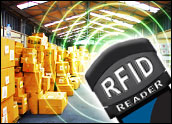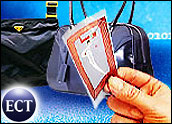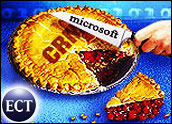
Radio frequency identification (RFID) tags have been around since World War II, when the British Royal Air Force affixed tags to planes as a way to distinguish friend from foe, but it wasn’t until 2003, when giant discount retailer Wal-Mart announced that it would require the tags on all shipments from its top 100 suppliers, that the buzz began in earnest.
With Wal-Mart and the Department of the Defense (DOD) now mandating compliance, RFID boosters believe tags might accomplish everything from monitoring the supply chain to inventorying repeat-customers’ closets, giving them washing instructions and matching one piece of clothing to another.
Slow Going
Experts agree, however, that despite the decrees, RFID is still struggling to gain a foothold.
Reasons for the sluggish adoption range from pure technology issues to questions about whether there really is a business case for RFID tags when widely used barcodes (which store less information than RFID tags) work so well.
“RFID continues to take step after step after step forward,” Jeff Woods, research vice president, Gartner, told CRMBuyer. “The pace is pretty good. The problem is that the expectation is that it would happen at lightning speed. If you look at reality versus expectation, it doesn’t look good.”
Lacking the Bridge
Anita Campbell, editor of RFID Weblog, said one of the main stumbling blocks to moving forward with tag adoption is not the tags or the readers, but the middleware that links those pieces of hardware to an enterprise’s various IT systems.
“The field of RFID middleware is still young. Technology vendors are feeling their way around and some still do not have a clear idea of what RFID middleware should do,” she said. “It’s like the early days of software when everything was a custom job because every manufacturer has different process needs and IT needs.”
Campbell also said that implementation is a huge undertaking and manufacturers should not attempt it in one fell swoop.
“Companies shouldn’t try to do the whole project at once because it’s complicated and they’re likely to take longer and get worse results,” she said. Instead, breaking the project down into manageable chunks can make all the difference.
“Companies may have to hire an outside expert, too, because they’re unlikely to have anyone in-house with the knowledge to do it,” she said, adding that experience is relative.
It’s All Relative
A recent survey from RFID Tribe, a member forum, found that 80 percent of respondents had less than five years in the industry and almost 60 percent had less than two years.
But Woods questioned whether the return on investment exists yet for manufacturers.
“One of the real problems with this industry is its fascination with technology advances and confusing them with business justification of the technology,” he said. “There will likely be more business cases that emerge, but it will take time.”
When you put together the cost of implementing an RFID system including hardware, software and process changes, the ROI just isn’t there yet, Woods believes.
“If everyone believes RFID tags are the next big thing, everyone will start buying them whether or not it makes sense, then it will make sense as people buy them because the price will drop. If the real issue was volume, the argument is close to true, but even with increases in demand, prices won’t come down that much because there’s not that much room for them to.”
Even Wal-Mart can’t force its suppliers to go beyond the bare bones.
“Wal-Mart suppliers are doing the least amount possible to comply, but when they do that, they aren’t getting all of the advantages of using the RFID tags,” Campbell said.
On the Cheap
Woods said that overall, even businesses that are using the tags are limiting their investment.
“People have come back to retailers and said, ‘We’re fine with the RFID pilot, but we would like to keep it inexpensive and we’re not going to expand it,'” Woods said about companies that try out the technology. “You can do RFID very inexpensively if you set your mind to it.”
The case for RFID in manufacturing is a more difficult one to make than some other, less sexy uses, Woods said.
“I’m positive about literally 100 business cases, it’s just the one everyone is hyperfocusing on has some real problems. They’re not insurmountable, but they’re problems,” he said. “Department of Defense applications are very easy to justify. So is finished vehicle tracking. You can lose cars on the lot, but not with RFID.”
He also cited a wheelchair tracking pilot program that five hospitals are participating in.
Drilling Down Too Deep
Implanting chips in individual products smacks too much of Big Brother for some, another obstacle in tag adoption.
“Privacy concerns and the potential for legislation have to be managed very carefully by the industry,” Campbell said.
But RFID plans such as Wal-Mart’s do not call for that level of tagging and Woods, for one, believes the retailer is also a real innovator.
“I really admire what Wal-Mart is doing here. They’re taking something that’s a crazy idea and they’re making it reality. It’s not going to work the way it was originally envisioned. There will be changes, different applications, but Wal-Mart’s listening and Wal-Mart’s adapting,” he said.
Perhaps where Wal-Mart goes, others will follow.











































